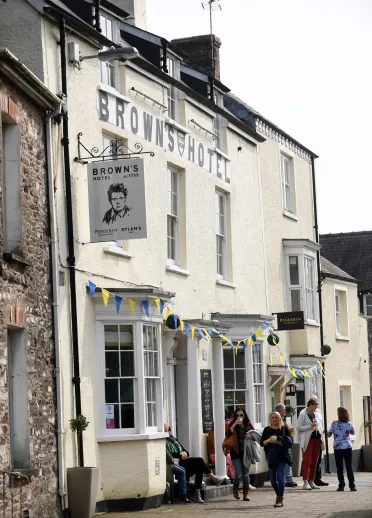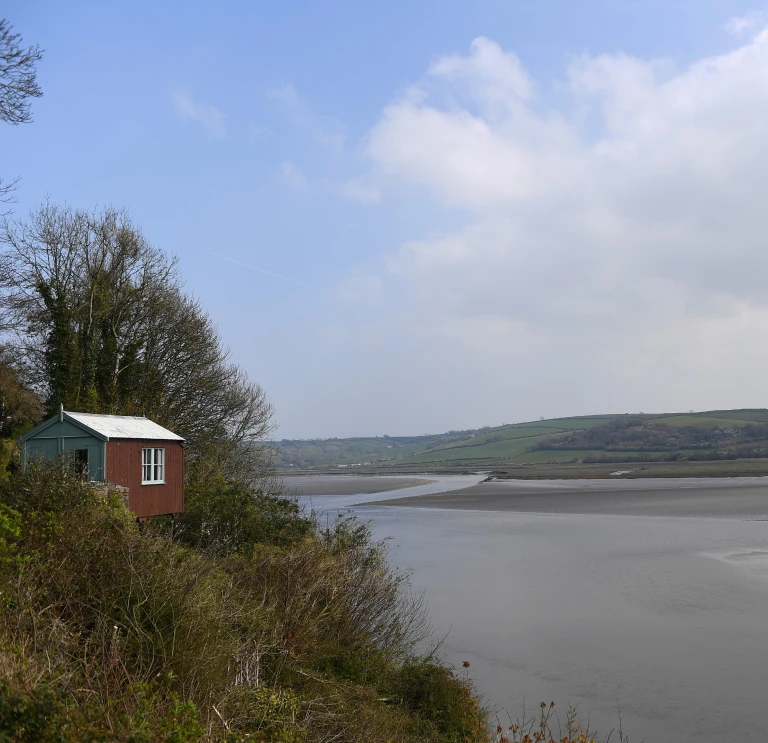Imagine how wonderful it could be if Dylan Thomas himself could take you himself around the loveliness of Laugharne, the Carmarthenshire estuary town which he first visited, and fell in love with, in 1934. He lived here, on-and-off, for nearly two decades. In his absence, we know someone who can fill his boots brilliantly: Dylan Thomas expert, archivist, collector and author Jeff Towns. Jeff pitches up to the Laugharne Weekend every April in his fabulous Dylan's Mobile Bookstore, dispensing wisdom and enthusiasm about the great man.
Let him take you by the hand, and lead you through the village that made Dylan the Laugharne local he was, dispensing some little-known insider’s stories as he goes.

Castle House, Market Street
'To begin at the beginning… this is where Dylan and Caitlin McNamara, as she was then, got together in 1936. The writer Richard Hughes, who was a friend of Dylan’s, lived in Castle House. Back then, the actual castle was part of his grounds, and he used to let Dylan write in a gazebo high on the ramparts, looking over the estuary. After Dylan and Caitlin got married in 1938, they moved into rooms here too. But they weren’t here for long…'

Eros, 2 Gosport Street
'This was the somewhat grandly-named fisherman's cottage that Dylan and Caitlin properly lived in Laugharne, in the lower part of the town, just up from the car park. It's much nicer now, but back then, it was in a terrible state. It had no plumbing at all – every morning, Dylan or Caitlin had to trek down the hill to get water from the public tap. Dylan was often seen staggering along, bucket in hand dressed in his pyjamas and overcoat!
'They only lasted here for six months. Dylan wrote to his American publisher, James Laughlin, from this house. In one of his letters, he describes Laugharne as “a very odd town”, adding that it was “a good place, undiscovered by painters… because the sea is mostly mud and nobody knows when the water will come in or go out or where it comes from anyway.” Dylan also liked that it only had a “few sprinkling trippers or picnickers. It’s a sociable place too…with good pubs and little law.” '

The Cross House Inn, The Grist
'The Cross House Inn was one of three pubs in Laugharne when Dylan first lived here, in the same corner of the town as Eros. Older locals still have memories of Dylan sitting cradling a beer in this pub, writing ideas for new poems and characters on Woodbine cigarette packets, sadly all swept up and thrown away by the bar staff.
'Dylan carried on drinking here, even when him and Caitlin moved up the hill – and he used to have fun with the pub’s name. In 1950, a begging letter for money that he sent to his friend, the Welsh painter Augustus John, ended with the words: “See you on the cross”. Yes, it was a macabre reference to death, but also a nod to one of his favourite pubs – and Augustus would have known that!'
Sea View, Market Lane
'After three months at Eros, Dylan and Caitlin moved to Sea View, just behind the castle . It was owned by the landlords of the Brown's Hotel, Ivy and Ebie Thomas, with whom they’d already made friends. By this point, Caitlin was heavily pregnant, expecting her and Dylan's first son, Llewellyn - both of them always said that their very happiest days were spent here. They had lots of room for visitors too, but then their debts to local businesses started piling up, so again they ran away, this time to Caitlin’s mother, in Hampshire.
'But Dylan pined for Laugharne. They couldn’t find another home here for a while, though, so they moved to the village of New Quay nearby in 1944, and five years later, came back to the place they really loved.'

The Boathouse, and Dylan’s writing shed
'Dylan and Caitlin moved into the Boathouse thanks to a very kind benefactor who loved Dylan’s writing. This was Margaret Taylor, wife of the historian AJP Taylor [who became famous for his televised BBC history lectures]. She put up some money for the boathouse for Dylan and Caitlin in 1949, and let them live in it, rent-free.
'Dylan wrote this letter to Margaret to thank her soon after: "for this place I love and where I want to work… this is it: the place, the house, the workroom, the time. All I shall write in this water and tree room on the cliff, every word will be my thanks to you. You have given me a life. And now I am going to live it." '
Dylan ThomasFor this place I love and where I want to work… this is it: the place, the house, the workroom, the time. All I shall write in this water and tree room on the cliff, every word will be my thanks to you. You have given me a life. And now I am going to live it.”
'After Dylan died in 1953, his mother, Florrie, moved into the boathouse [Dylan’s father, David John, had died the previous Christmas]. Florrie would love having people come round there wanting to know more about her boy. She’d cut his signature off letters from him and give it to people, she was so proud of him.
'The Boathouse is a museum, shop and tearoom now, then there’s the writing shed of course, with all the paraphernalia around, and that view. If you couldn’t write poetry there, you couldn’t write it anywhere.'


Pelican House, King Street
'Pelican House is where Dylan’s parents lived, right opposite the pub – again, this was a place rented out by the Brown's landlords. Dylan moved them here in 1949, and he’d call in here every day, stopping do the crossword with his dad. This is also where Dylan’s body came back to after he died. The story is that the coffin came back on an ocean-going liner from New York, and sailors were playing cards on top of it when Caitlin found them below deck. She ended up dancing on top of it. The drivers also got lost on the way back from the port, and ended up in Cornwall… but when they eventually got back to Laugharne, the door was too small for the coffin to go through. So if you stand here outside the window – that’s the way he went in.'


Brown's Hotel, King Street
'Brown's Hotel really was Dylan’s favourite. He sat down for tea here for the first time on the afternoon of 21 May 1934, on his first ever visit to Laugharne. After he moved to the village, he called in the pub most mornings for tea and some breakfast, and he drank there most nights, often accompanied by Caitlin. He was there so often, he would give the hotel phone number as his own.
'Here, Dylan would also sit in the corner ‘mouldering’, as he called it – writing at a wrought-iron window table, or playing cards, listening to the conversations of the locals that swirled around the bar. These would help form the raw materials for Under Milk Wood.
'I also used to go here with his daughter, Aeronwy, when she was alive. She remembered her dad playing shove‐halfpenny and skittles here, and make me laugh about how the landlords over the years paid tribute to him. One said he had Dylan and Caitlin’s nuptial bed upstairs, and would point out the dartboard on the wall to American tourists, saying, “That’s where Dylan played darts.” Dylan would have loved though, wouldn’t he? This was like his front room.
'And, of course, his wake was here, as it should have been. It's now owned by Nigel Short, who runs Penderyn Whisky, so the bar is always well-stocked.'
St Martin’s Church, Church Street
'Dylan is buried at St Martin’s Church in Church Street, in a very plain grave – there’s only a white wooden cross that’s replaced every now and then. It’s a simple, beautiful thing. It attracts rays of sunlight, and you see it all the time once you notice it.
'His wife, Caitlin, is buried here too. This surprised some people as she moved to Italy after Dylan died, was with another partner the rest of her life, and had another son. She had come here in the mid-1980s on a book tour – the first time she’d been in the village for many years. On that trip, she spoke to the vicar, and arranged to be buried in the graveyard. It says a lot about the ties that still existed from her first marriage, even though it was a very torturous relationship. Her name is written on one side of the cross, as you look at it from the top of the road, while Dylan’s is on the other.'
St John’s Hill
'This is just to the south of the town, and where Dylan walked on his 30th birthday, before writing the beautiful Poem In October. A local farmer and councillor, Bob Stevens, set up the splendid Dylan Thomas Birthday Walk, some years ago now, following the route of the poem – and you can still do it today.
'There’s a series of benches at key points along the two-mile trail, with lines from the poem inscribed on that reflect the parts in the poem. As an added bonus, those who complete the walk on their birthday, and present ID at various local pubs and cafés, can claim a free birthday pint or a portion of fish and chips from Laugharne’s famous chippie. I recommend eating them on the benches across the road by the castle while reading the poem again, and thinking about how much this town meant to the man who really lived in it.'


Find out more about Laugharne
Fancy a magical holiday in beautiful Laugharne? Search for accommodation, attractions and activities in the area.







